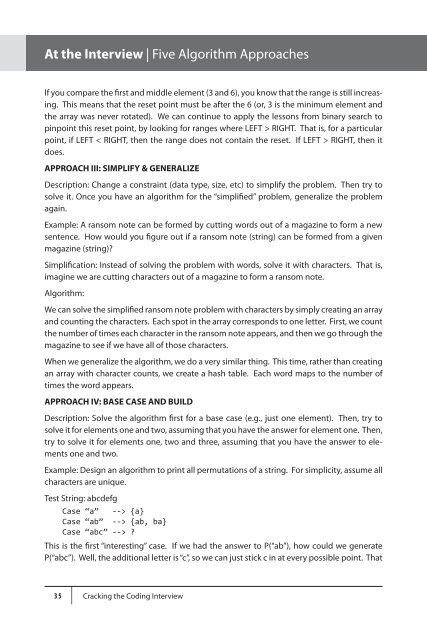Cracking the Coding Interview, 4 Edition - 150 Programming Interview Questions and Solutions
Cracking the Coding Interview, 4 Edition - 150 Programming Interview Questions and Solutions
Cracking the Coding Interview, 4 Edition - 150 Programming Interview Questions and Solutions
You also want an ePaper? Increase the reach of your titles
YUMPU automatically turns print PDFs into web optimized ePapers that Google loves.
At <strong>the</strong> <strong>Interview</strong> | Five Algorithm Approaches<br />
If you compare <strong>the</strong> first <strong>and</strong> middle element (3 <strong>and</strong> 6), you know that <strong>the</strong> range is still increasing.<br />
This means that <strong>the</strong> reset point must be after <strong>the</strong> 6 (or, 3 is <strong>the</strong> minimum element <strong>and</strong><br />
<strong>the</strong> array was never rotated). We can continue to apply <strong>the</strong> lessons from binary search to<br />
pinpoint this reset point, by looking for ranges where LEFT > RIGHT. That is, for a particular<br />
point, if LEFT < RIGHT, <strong>the</strong>n <strong>the</strong> range does not contain <strong>the</strong> reset. If LEFT > RIGHT, <strong>the</strong>n it<br />
does.<br />
APPROACH III: SIMPLIFY & GENERALIZE<br />
Description: Change a constraint (data type, size, etc) to simplify <strong>the</strong> problem. Then try to<br />
solve it. Once you have an algorithm for <strong>the</strong> “simplified” problem, generalize <strong>the</strong> problem<br />
again.<br />
Example: A ransom note can be formed by cutting words out of a magazine to form a new<br />
sentence. How would you figure out if a ransom note (string) can be formed from a given<br />
magazine (string)?<br />
Simplification: Instead of solving <strong>the</strong> problem with words, solve it with characters. That is,<br />
imagine we are cutting characters out of a magazine to form a ransom note.<br />
Algorithm:<br />
We can solve <strong>the</strong> simplified ransom note problem with characters by simply creating an array<br />
<strong>and</strong> counting <strong>the</strong> characters. Each spot in <strong>the</strong> array corresponds to one letter. First, we count<br />
<strong>the</strong> number of times each character in <strong>the</strong> ransom note appears, <strong>and</strong> <strong>the</strong>n we go through <strong>the</strong><br />
magazine to see if we have all of those characters.<br />
When we generalize <strong>the</strong> algorithm, we do a very similar thing. This time, ra<strong>the</strong>r than creating<br />
an array with character counts, we create a hash table. Each word maps to <strong>the</strong> number of<br />
times <strong>the</strong> word appears.<br />
APPROACH IV: BASE CASE AND BUILD<br />
Description: Solve <strong>the</strong> algorithm first for a base case (e.g., just one element). Then, try to<br />
solve it for elements one <strong>and</strong> two, assuming that you have <strong>the</strong> answer for element one. Then,<br />
try to solve it for elements one, two <strong>and</strong> three, assuming that you have <strong>the</strong> answer to elements<br />
one <strong>and</strong> two.<br />
Example: Design an algorithm to print all permutations of a string. For simplicity, assume all<br />
characters are unique.<br />
Test String: abcdefg<br />
Case “a” --> {a}<br />
Case “ab” --> {ab, ba}<br />
Case “abc” --> ?<br />
This is <strong>the</strong> first “interesting” case. If we had <strong>the</strong> answer to P(“ab”), how could we generate<br />
P(“abc”). Well, <strong>the</strong> additional letter is “c”, so we can just stick c in at every possible point. That<br />
3 5<br />
<strong>Cracking</strong> <strong>the</strong> <strong>Coding</strong> <strong>Interview</strong>


